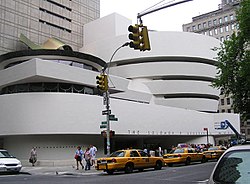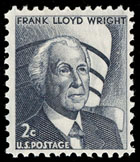Wikipedia:WikiProject National Register of Historic Places/NHLsandbox11
Solomon R. Guggenheim Museum | |
 The front of the Guggenheim Museum from 5th Avenue | |
| Location | 1071 Fifth Avenue, New York, New York |
|---|---|
| Area | .6647 acre[1] |
| Architect | Frank Lloyd Wright |
| NRHP reference No. | ___ |
| Added to NRHP | [[___]], 2008 |
- This article refers to the Guggenheim Museum in the Upper East Side of Manhattan (New York). There are a number of other Guggenheim Museums.
THIS IS A SANDBOX VERSION, MODIFYING FROM JULY 10 MAIN VERSION, TO ADD NHL INFO AND OTHERWISE DEVELOP.
The Solomon R. Guggenheim Museum, founded in 1937, is a modern art museum located on the Upper East Side in New York City. It is the best-known of several museums owned and/or operated by the Solomon R. Guggenheim Foundation, and is often called simply The Guggenheim. It is one of the best-known museums in New York City. The main part of the building is a very unusual shape, and was designed by Frank Lloyd Wright.
It was designated a U.S. National Historic Landmark on [[___]], 2008.[1]
History[edit]

Originally called "The Museum of Non-Objective Painting," the Guggenheim was founded to showcase avant-garde art by early modernists such as Rudolf Bauer, Hilla Rebay, Wassily Kandinsky and Piet Mondrian. It moved to its present location, at the corners of 89th Street and Fifth Avenue (overlooking Central Park), in 1959, when Frank Lloyd Wright's design for the site was completed.
The distinctive building, Wright's last major work, instantly polarized architecture critics upon completion,[2] though today it is widely revered.[3] From the street, the building looks approximately like a white ribbon curled into a cylindrical stack, slightly wider at the top than the bottom. Its appearance is in sharp contrast to the more typically boxy Manhattan buildings that surround it, a fact relished by Wright who claimed that his museum would make the nearby Metropolitan Museum of Art "look like a Protestant barn."[2]
Internally, the viewing gallery forms a gentle spiral from the ground level up to the top of the building. Paintings are displayed along the walls of the spiral and also in viewing rooms found at stages along the way.

Most of the criticism of the building has focused on the idea that it overshadows the artworks displayed within, and that it is particularly difficult to properly hang paintings in the shallow windowless exhibition niches that surround the central spiral. Although the rotunda is generously lit by a large skylight, the niches are heavily shadowed by the walkway itself, leaving the art to be lit largely by artificial light. The walls of the niches are neither vertical nor flat (most are gently concave), meaning that canvasses must be mounted proud of the wall's surface. The limited space within the niches means that sculptures are generally relegated to plinths amid the main spiral walkway itself. Prior to its opening, twenty-one artists, including Willem de Kooning and Robert Motherwell, signed a letter protesting the display of their work in such a space.[2]

In 1992, the building was supplemented by an adjoining rectangular tower, taller than the original spiral, designed by the architectural firm of Gwathmey Siegel and Associates.[4] By that point, the building had become iconic enough that this augmentation of Wright's original design was itself controversial.
In October 2005, Lisa Dennison, a longtime Guggenheim curator, was appointed director of the Solomon R. Guggenheim Museum in New York. Dennison resigned in July 2007 to work at the auction house Sotheby's.[5]
From October 2005 to February 2008, Thomas Krens remained director of the Solomon R. Guggenheim Foundation, having won a decisive victory over billionaire philanthropist and board member Peter Lewis. A significant contributor to the Guggenheim Foundation, Lewis resigned in 2005 in a dispute with the board over the direction and leadership of the Foundation. Despite this, Krens and Lewis nevertheless continue to agree in describing the building itself as "the most important piece of art in the collection."[6]
In February 2008, Krens stepped down as the Director of the Guggenheim Foundation, but remains an advisor to the Guggenheim's international expansion projects. A search is currently underway for a new Director, who will head both the New York museum and the Foundation.[7]
2007-2008 exterior restoration[edit]
The Guggenheim’s exterior and infrastructure will be restored, requiring only limited structural interventions. Experts in the field of landmark restoration and preservation formulated a methodology –- using the latest techniques and materials unavailable to Frank Lloyd Wright in the 1950s.
In the first phase of this project, a team of restoration architects, structural engineers, and architectural conservators worked together to create a comprehensive assessment of the building's current condition. This included
- the removal of 11 coats of paint from the original surface, revealing hundreds of cracks caused over the years, primarily from seasonal temperature fluctuations[8]
- detailed monitoring of the movement of selected cracks over 17 months
- impact-echo technology, in which sound waves are sent into the concrete and the rebound is measured in order to locate voids within the walls
- extensive laser surveys of the exterior and interior surfaces, believed to be the largest laser model ever constructed
- core drilling to gather samples of the original concrete and other construction materials
- testing of potential repair materials.[9]
Much of the interior of the building was restored during the 1992 renovation and addition by Gwathmey Siegel and Associates Architects. The 2007-2008 restoration primarily addresses the exterior of the original building and the infrastructure. This includes the skylights, windows, doors, concrete and gunite facades and exterior sidewalk, as well as the climate-control. The goal will be to preserve as much significant historical fabric of the Solomon R. Guggenheim Museum as possible, while accomplishing necessary repairs and attaining a suitable environment for the building’s continuing use as a museum.[10]
The $29 million restoration is made possible through the support of Peter B. Lewis, the Board of Trustees of the Solomon R. Guggenheim Foundation, the City of New York and the State of New York. The restoration work is projected to be complete and the scaffolding to come down by late spring of 2008. [11]
Significance in popular culture[edit]
The building has become a cultural icon, and has been shown in scenes in many movies, including Bye Bye Birdie, L.A. Story, Men in Black, Downtown 81 and mentioned on Seinfeld.
See also[edit]
References[edit]
- ^ a b {{citation|title=Monica Ramirez Montagut and James A. Jacobs (February 13, 2007). "National Historic Landmark Nomination: Solomon R. Guggeheim Museum / Guggenheim Museum (common)" (PDF). National Park Service.
- ^ a b c "Last Monument," Time. November 2, 1959.
- ^ "The Wright Stuff," USAToday (Weekend). November 6, 1998]
- ^ Gwathmey Siegel web site: Overview of firm's history, projects, etc.
- ^ Vogel, Carol. "Director of Guggenheim Resigns to Join Sotheby’s," New York Times. July 31, 2007.
- ^ Vogel, Carol. "Guggenheim Museum Seeks to Restore Its Most Valuable Asset: Itself," New York Times. June 10, 2004.
- ^ Vogel, Carol. "Guggenheim’s Provocative Director Steps Down," New York Times. February 28, 2008
- ^ Haeyoun Park."Face-lift for an Aging Museum," New York Times. April 16, 2007. -- graphic illustration of cracking.
- ^ Pogrebin, Robin. "The Restorers' Art of the Invisible," New York Times. September 10, 2007, pp. E1-5.
- ^ Guggenheim Museum web site: click link to podcast about restoration (10 MB, audio only, 8 min 45 sec)
- ^ Guggenheim Museum web site: click link to streaming video, broadband only
External links[edit]
- Official website
- Gwathmey Siegel Solomon R. Guggenheim Museum Renovation and Addition project page
- Architectural Review
- Art of the Motorcycle Exhibit
40°46′58.71″N 73°57′32.37″W / 40.7829750°N 73.9589917°W
[[Category:National Historic Landmarks in New York]] [[Category:Museums in Manhattan|Guggenheim Museum]] [[Category:Frank Lloyd Wright buildings|Guggenheim Museum]] [[Category:Guggenheim family]] [[Category:Modern art museums|Guggenheim Museum]] [[Category:Art museums and galleries in New York|Guggenheim Museum]] [[Category:Fifth Avenue (Manhattan)|Guggenheim]] [[Category:Museums established in 1937|Guggenheim Museum]] [[Category:1959 architecture|Guggenheim Museum]] [[ca:Museu Guggenheim (Nova York)]] [[cs:Guggenheimovo muzeum]] [[de:Solomon R. Guggenheim Museum]] [[es:Solomon R. Guggenheim Museum]] [[fa:موزه گوگنهایم نیویورک]] [[fr:Musée Solomon R. Guggenheim]] [[hr:Guggenheim muzej u New Yorku]] [[it:Museo Guggenheim (New York)]] [[he:מוזיאון סולומון ר. גוגנהיים]] [[ka:გუგენჰაიმის მუზეუმი (ნიუ-იორკი)]] [[nl:Guggenheim Museum (New York)]] [[ja:グッゲンハイム美術館]] [[no:Solomon R. Guggenheim Museum]] [[pt:Museu Solomon R. Guggenheim]] [[ru:Музей современного искусства Соломона Гуггенхайма]] [[fi:Solomon R. Guggenheim Museum]] [[sv:Solomon R. Guggenheim Museum]] [[vi:Bảo tàng Guggenheim]] [[tr:Solomon R. Guggenheim Müzesi]] [[zh:古根漢美術館 (紐約)]]
